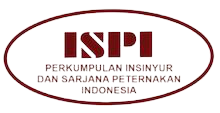KAJIAN PENGOLAHAN LIMBAH TERNAK SAPI POTONG DI KECAMATAN CIPATUJAH KABUPATEN TASIKMALAYA
Abstract
Processing of waste from beef cattle business is an effort to reduce environmental pollution. Good waste treatment will produce good quality compost. The purpose of this study was to determine the waste treatment process and compost quality including shrinkage (20-60%), odor (no smell), color (dark brown/black), and texture (crumbs). This study uses a survey method. Data collection was carried out by interviews, observations, and organoleptic tests in Cipatujah District on the Harapan 3, Sadar Bakti 3, Sejahtera, Mulyasari livestock groups. The informants were selected using purposive sampling and data were processed through editing and tabulation. The research results show that waste processing in all livestock groups uses the heap and indore methods. The temperature in the composting process includes the mesophilic phase ranges of 27-32°C, thermophilic phase ranges of 37-45°C, decreasing temperature ranges of 26-31°C and cooling and maturation the compost ranges of 20-25°C. Compost quality in Hope Group 3: Shrinkage (50%), Odor (odorless), Color (blackish brown), Texture (crumbs); in the Sadar Bakti Group: Shrinkage (28.7%), Odor (odorless), Color (black), Texture (crumbs); in the Prosperous Group: Shrinkage (50%), Odor (odorless), Color (black), Texture (crumbs); in the Mulyasari Group: Shrinkage (60%), Odor (odorless), Color (black), Texture (slightly sticky).
Full Text:
PDF (Bahasa Indonesia)References
Deasy A. W dan P. Widiyaningrum (2016). Penggunaan EM4 dan MOL limbah tomat sebagai bioaktivator pada pembuatan kompos. Life Sci-ence Journal of Biology, 5 (1), 18-24. http://journal.unnes.ac.id/sju/index.php/UnnesJLifeSci
Dewilda, Y. dan Maulidya, A. (2017). Effect of Raw Materials Composting Fruits and Vegetables Waste (Tithonia Diversifolia) to Quality and Quantity of Compost. International Conference of App-lied Science on Engineering, Busi-ness, Linguistics and Information Technology, 344-352.
Dewi, A. A., Marlina, E. T. dan Hida-yati, Y. A. (2022). Pengaruh Cam-puran Ekskreta Ayam Petelur dan Serasah Dedaunan pada Vermi-composting terhadap Nisbah C/N dan Penyusutan Vermicompost. Jurnal Teknologi Hasil Peternakan, 3 (1), 42-48.
Kumalasari, R dan E. Zulaika. (2016). Pengomposan Daun Mengguna-kan Konsorsium Azotobacter. Jur-nal Sains dan Seni ITS, 5 (2): 64-66. http://doi.org/10.12962/j23373520.v5i2.20679
Kurnia, V. C., Sumiyati, S. dan Samu-dro, G. (2017). Pengaruh kadar air terhadap hasil pengomposan sampah organik dengan metode open windrow. Jurnal Teknik Mesin Mercu Buana, 6 (2), 119-123.
Marlina, E. T., Kurnani, T. B., Hidayati, Y. A. dan Badruzzaman, D. Z. (2017). Penyusutan dan penurunan nisbah C/N pada vermicompos-ting campuran feses sapi perah dan jerami padi menggunakan Eisenia fetida. Jurnal Ilmu Ternak Univer-sitas Padjadjaran, 17(2), 114-119. https://doi.org/10.24198/jit.v17i2.16841
Mauludin, M. A. (2012). Peran Kelom-pok dalam Mengembangkan Ke-berdayaan Peternak Sapi Potong (Kasus Di Wilayah Selatan Kabu-paten Tasikmalaya). Jurnal Ilmu Ternak Universitas Padjadjaran, 12 (2), 1-8.
https://doi.org/10.24198/jit.v12i2.5120
Novitamala, C. B., Suwerda, B. dan Werdiningsih, I. (2015). Efektifitas berbagai dosis bio-slurry sebagai bumbu kompos terhadap waktu pembentukan dan kualitas kompos di dusun Gadingharjo, Donotirto, Kretek, Bantul. Sanitasi: Jurnal Kesehatan Lingkungan, 7 (2), 51-58. https://doi.org/10.29238/sanitasi.v7i2.717
Peraturan Menteri Pertanian. (2019). Nomor 1 Tahun 2019 Tentang Pendafataran Pupuk Organik, Pupuk Hayati dan Pembenah Tanah.
Pratama, B. A., Sabrina, T. dan Sem-biring, M. (2017). Uji Efektifitas Be-berapa Jenis Dekomposer Pada Be-berapa Jenis Bahan Kompos. Jurnal Pertanian Tropik. 6 (1), 142- 152.
https://jurnal.usu.ac.id/index.php/Tropik
Ratna, D. A. P., Samudro, G. dan Sumiyati, S. (2017). Pengaruh kadar air terhadap proses pengomposan sampah organik dengan metode takakura. Jurnal Teknik Mesin, 6. 124 – 128.
Subula, R., Uno, W. D. dan Abdul, A. (2022). Kajian Tentang Kualitas Kompos Yang Menggunakan Bio-aktivator Em4 (Effective Micro-organism) Dan Mol (Mikro-organisme Lokal) Dari Keong Mas. Jambura Edu Biosfer Journal, 4 (2), 54-64.
Shilev, S., Naydenov, M., Vancheva, V. dan Aladjadjiyan, A. (2007). Com-posting of food and agricultural wastes. Utilization of by-products and treatment of waste in the food industry. 283-301.
Suwatanti, E. dan Widiyaningrum, P. (2017). Pemanfaatan MOL limbah sayur pada proses pembuatan kompos. Indonesian Journal of Mathematics and Natural Sciences, 40 (1), 1-6.
https://doi.org/10.15294/ijmns.v40i1.12455
Wahyudin, W. dan Nurhidayatullah, N. (2018). Pengomposan Sampah Organik Rumah Tangga Meng-gunakan Mikroorganisme Lokal Bonggol Pisang Sebagai Bioakti-vator. Jurnal Agriovet, 1 (1), 19-36. https://www.ejournal.kahuripan.ac.id/index.php/agriovet/issue/view/20
Yani, H., Rahmawati, R. dan Rahmi, F. (2018). Kualitas Fisika Dan Kimia Kompos Eceng Gondok (Euchornia Crasipess) Menggunakan Aktiva-tor Em-4. Jurnal Konversi, 7 (2),1-8. https://doi.org/10.24853/konversi.7.2.8
DOI: https://doi.org/10.24198/jthp.v5i1.50824
Refbacks
- There are currently no refbacks.
Copyright (c) 2024 Jurnal Teknologi Hasil Peternakan

This work is licensed under a Creative Commons Attribution-NonCommercial 4.0 International License.
Jurnal Teknologi Hasil Peternakan is indexed in:






